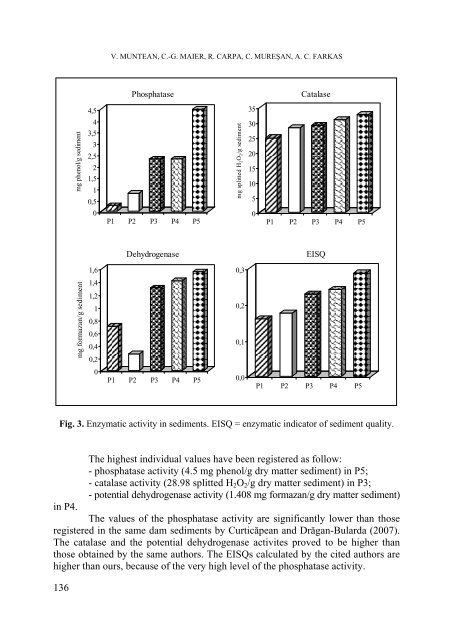biologia - Studia
biologia - Studia
biologia - Studia
You also want an ePaper? Increase the reach of your titles
YUMPU automatically turns print PDFs into web optimized ePapers that Google loves.
V. MUNTEAN, C.-G. MAIER, R. CARPA, C. MUREŞAN, A. C. FARKAS<br />
Phosphatase<br />
Catalase<br />
4,5<br />
35<br />
mg phenol/g sediment<br />
4<br />
3,5<br />
3<br />
2,5<br />
2<br />
1,5<br />
1<br />
0,5<br />
0<br />
P1 P2 P3 P4 P5<br />
mg splitted H 2 O 2 /g sediment<br />
30<br />
25<br />
20<br />
15<br />
10<br />
5<br />
0<br />
P1 P2 P3 P4 P5<br />
Dehydrogenase<br />
EISQ<br />
1,6<br />
0,3<br />
mg formazan/g sediment<br />
1,4<br />
1,2<br />
1<br />
0,8<br />
0,6<br />
0,4<br />
0,2<br />
0,2<br />
0,1<br />
0<br />
P1 P2 P3 P4 P5<br />
0,0<br />
P1 P2 P3 P4 P5<br />
Fig. 3. Enzymatic activity in sediments. EISQ = enzymatic indicator of sediment quality.<br />
The highest individual values have been registered as follow:<br />
- phosphatase activity (4.5 mg phenol/g dry matter sediment) in P5;<br />
- catalase activity (28.98 splitted H 2 O 2 /g dry matter sediment) in P3;<br />
- potential dehydrogenase activity (1.408 mg formazan/g dry matter sediment)<br />
in P4.<br />
The values of the phosphatase activity are significantly lower than those<br />
registered in the same dam sediments by Curticăpean and Drăgan-Bularda (2007).<br />
The catalase and the potential dehydrogenase activites proved to be higher than<br />
those obtained by the same authors. The EISQs calculated by the cited authors are<br />
higher than ours, because of the very high level of the phosphatase activity.<br />
136
















